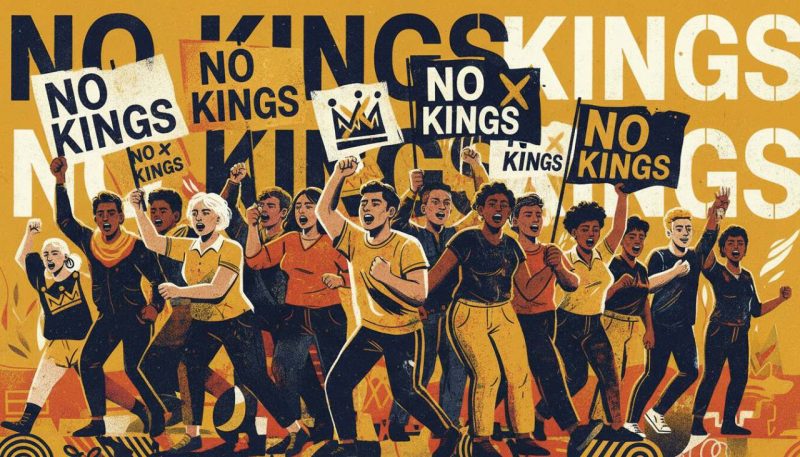The “No Kings” protests are set to cascade across the United States on Oct. 18, with organizers projecting more than 2,500 rallies—potentially one of the largest single days of protest in American history. WATCH LIVE HERE The coalition behind the June demonstrations says the aim is simple: defend the First Amendment and reject executive overreach they say has accelerated under President Donald Trump’s second term.

Participants are urged to wear yellow, a visual signature borrowed from global pro‑democracy movements, and to keep it nonviolent and local—from big-city anchor events to small-town courthouse steps. Organizers include Indivisible, the ACLU, Public Citizen, SEIU, MoveOn, and more than 200 partners, with expectations that turnout could rival or exceed June’s multimillion-person actions.
What Is “No Kings”?
At its core, No Kings is a reminder that American government is republican, not monarchical—power belongs to the people. The June marches framed that message against a military parade and Trump’s 79th birthday; October’s reprise claims urgency amid a government shutdown, stepped-up immigration enforcement, and a more openly militarized posture in some cities. Organizers pitch the day as festive but purposeful: music, chants, mutual aid—and know‑your‑rights cards—anchored by an insistence on nonviolence and mass visibility.
Why October 18 Matters
This is not just a sequel; it’s a stress test for democratic participation. If June was proof-of-concept, October is about scale and staying power. Organizers argue that sustained, local, nonviolent action can bend institutions—citing decades of research on mass movements and the (often-misunderstood) “3.5% rule.” Whether or not the country approaches that threshold, the strategic bet is clear: normalize dissent everywhere, from Bozeman to Boston, and force a reckoning with the use—and abuse—of executive power (Guardian).
Who’s Organizing
A sprawling coalition is coordinating the day: Indivisible, ACLU, Public Citizen, SEIU, Human Rights Campaign, American Federation of Teachers, United We Dream, MoveOn, League of Conservation Voters, and the distributed “50501” network, among others. Many groups have trained marshals in de-escalation, vetted local hosts, and built out safety protocols. This is movement infrastructure—modular, local-first, and designed to outlast one day’s headlines.
Where Protests Are Happening
Everywhere. Anchor events are slated in Washington, D.C., New York, Chicago, San Francisco, Atlanta, Boston, Kansas City, New Orleans, Houston, San Diego, Honolulu, and Bozeman—alongside thousands of small-town actions. The distributed model is the point: demonstrate broad geographic consent for democratic norms, not just urban turnout. Local outlets have mapped neighborhood-level details from Ohio to upstate New York, underlining the ground-up nature of the mobilization.
The Symbolism of Yellow
Yellow serves as the movement’s connective tissue: visible, camera-friendly, and legible at a distance. It’s also a nod to other nonviolent pro‑democracy movements globally. In an information environment that rewards spectacle, color becomes message discipline: a sea of yellow that says “no monarchs here” before a single chant is heard.
Historical Context and Precedent
June’s No Kings actions drew millions nationwide—estimates vary but consistently place it among the largest one-day protests since the 2017 Women’s March. Organizers tout that scale not as a trophy but as leverage; critics counter that head counts don’t move budgets or ballots. Both can be true. Movements often win indirectly: by hardening the political spine of allies, shifting media frames, and raising the cost of authoritarian tactics. That’s the longer game being played here.
Expected Turnout and Scale
The coalition projects more than 2,500 events in all 50 states and anticipates turnout that could match or surpass June—organizers and sympathetic analysts invoke “largest single-day protest” language, while acknowledging uncertainties inherent in decentralized actions. USA Today’s coverage points to extensive training and safety planning that suggests an event sized for millions, not thousands.
Legal Rights and Peaceful Assembly
Organizers have been explicit: nonviolence is non-negotiable. The ACLU and partners have hosted mass safety calls, created marshaling guides, and pushed know‑your‑rights materials, anticipating tense moments where federal or state enforcement intersects with First Amendment claims. Expect a rights-forward posture—assertive but disciplined—especially in cities with National Guard deployments or heightened federal presence.
The Politics Around the Protests
Trump allies have tried to pre-frame the day as “hate America” or “antifa” rallies and, in some cases, to link them to the ongoing shutdown. It’s a familiar playbook: delegitimize mass dissent as security threat. The coalition’s counter is to make the crowds look exactly like the country—teachers, nurses, veterans, students—wearing yellow and singing. Public opinion isn’t moved by hashtags alone; it’s moved by neighbors standing together on Main Street. That’s the narrative contest on Oct. 18.
What to Wear and Bring
Think practical: yellow shirt or bandana; comfortable shoes; water; snacks; a portable battery; a sharpie and emergency contacts on your arm; sign with a clear, readable message; and any prescribed meds. If you’re a first-timer, pair up with a buddy, identify exit routes, and save a local legal hotline if one is provided by organizers. The strongest movements care for one another—before, during, and after the march (organizer guidance summarized from multi-source reporting).
Beyond the March: Next Steps for Civic Action
Movements that endure translate turnout into influence. That means signing up with local chapters (Indivisible, unions, immigrants’ rights groups), showing up at council and school board meetings, pressuring statehouses on gerrymanders and voting rules, and defending civil society infrastructure under stress. October 18 is a moment; the work is cycles long.
